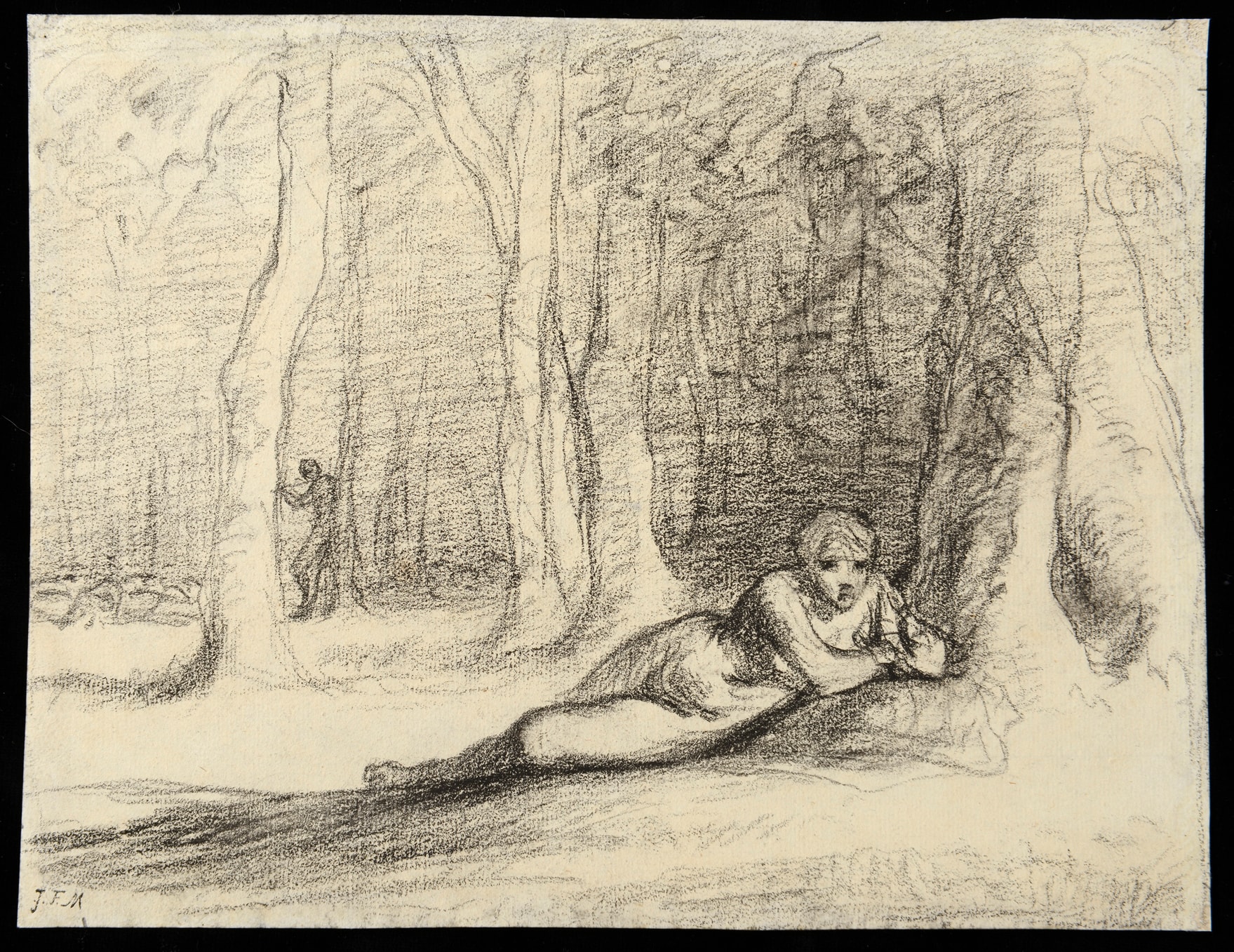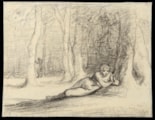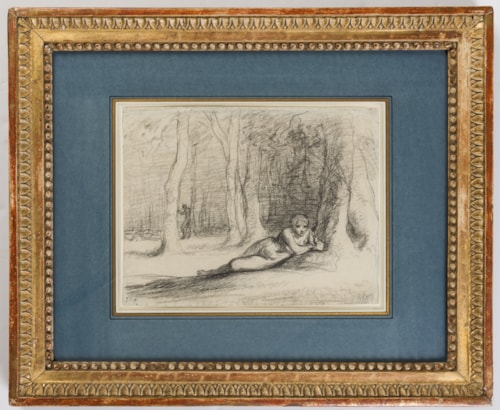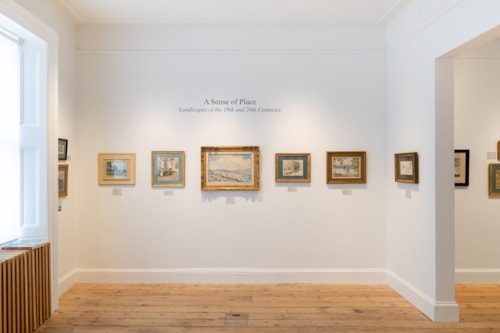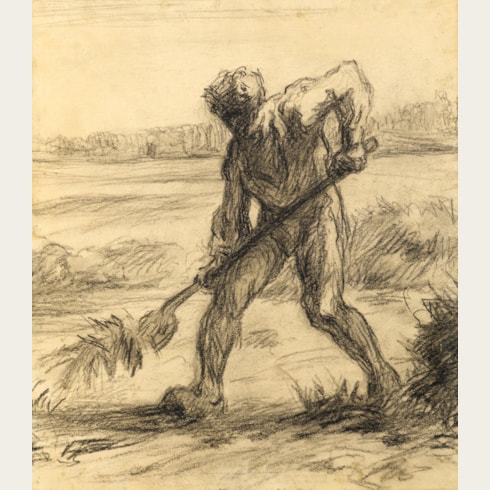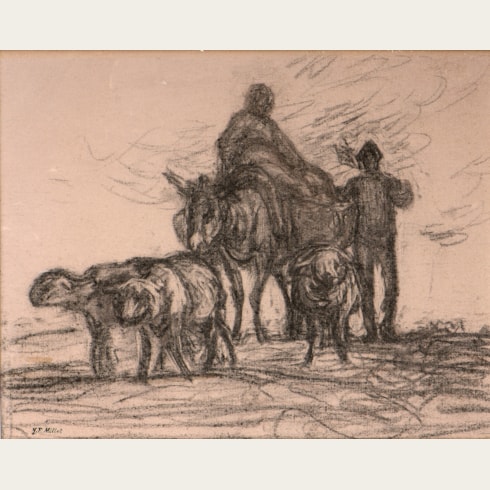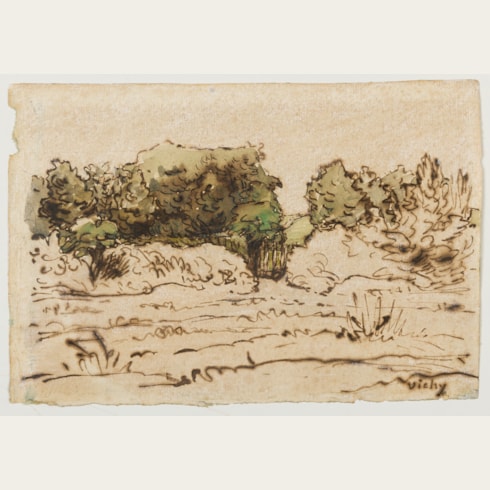Jean-François MILLET
(Gruchy 1814 - Barbizon 1875)
A Reclining Nymph in a Wooded Landscape
Sold
Black conté crayon.
203 x 262 mm. (8 x 10 3/8 in.) [sheet]
203 x 262 mm. (8 x 10 3/8 in.) [sheet]
After his arrival in Paris in 1846, Jean-François Millet produced a series of paintings and drawings in which female nudes are prominent. Perhaps inspired by the work of Watteau, Fragonard and Boucher, he painted around twenty-five small-scale paintings of female nudes in bucolic settings, typified by such works as A Woman Reclining in a Landscape of c.1846-1847, in the Museum of Fine Arts in Boston. These paintings, sometimes mildly erotic in nature, seem to have been painted with a view to having more immediate commercial appeal than the larger works he was painting for the Salons. At the same time, Millet made around fifty drawings that can be related to this same trend, although they remain a very small part of his oeuvre as a draughtsman as a whole. By the end of the decade, Millet had turned his attention to peasant subjects, and such depictions of female nudes largely disappeared from his oeuvre for the remainder of his career.
This fine drawing may be grouped with a relatively small number of early chalk drawings of female nudes, datable to the second half of the 1840s. As Alexandra Murphy has noted, ‘For an artist seeking to establish himself in the art circles of Paris, the nude was a perfect vehicle. It bespeaks both tradition and immediacy. If we see the exploration of timelessness as one of the many recurring themes in Millet’s oeuvre, then Millet’s female nude drawings, almost always without literary references or anecdotal accoutrements, fit this mold as easily as his scenes of peasants in Barbizon.’ Among stylistically comparable drawings of single female nudes of this date are several examples in the Louvre, including a study of a bather on blue-grey paper and another of a woman putting on her chemise, as well as a Reclining Nude in a private collection. The bucolic setting of this drawing, and the presence of a figure playing music in the background, give the composition an air of a scene from mythology or classical literature, although Millet allows no references to a specific theme.
Only a handful of complete figural compositions of this type are known from Millet’s drawn oeuvre of the late 1840s, including a signed black chalk drawing of Lot and his Daughters, which was on the art market in New York in 1999, in which a similar reclining female nude is found, as well as an oval drawing of Lovers in the Art Institute of Chicago and a study of an Idyll (also known as Confidences) in the Louvre.
This fine drawing may be grouped with a relatively small number of early chalk drawings of female nudes, datable to the second half of the 1840s. As Alexandra Murphy has noted, ‘For an artist seeking to establish himself in the art circles of Paris, the nude was a perfect vehicle. It bespeaks both tradition and immediacy. If we see the exploration of timelessness as one of the many recurring themes in Millet’s oeuvre, then Millet’s female nude drawings, almost always without literary references or anecdotal accoutrements, fit this mold as easily as his scenes of peasants in Barbizon.’ Among stylistically comparable drawings of single female nudes of this date are several examples in the Louvre, including a study of a bather on blue-grey paper and another of a woman putting on her chemise, as well as a Reclining Nude in a private collection. The bucolic setting of this drawing, and the presence of a figure playing music in the background, give the composition an air of a scene from mythology or classical literature, although Millet allows no references to a specific theme.
Only a handful of complete figural compositions of this type are known from Millet’s drawn oeuvre of the late 1840s, including a signed black chalk drawing of Lot and his Daughters, which was on the art market in New York in 1999, in which a similar reclining female nude is found, as well as an oval drawing of Lovers in the Art Institute of Chicago and a study of an Idyll (also known as Confidences) in the Louvre.
One of the founders of the Barbizon school of painting in France, Jean-François Millet studied at the Ecole des Beaux-Arts in Paris. It was in Paris in the 1840’s that Millet became associated with a group of landscape painters who were to become part of the Barbizon circle, including Théodore Rousseau, Constant Troyon, Narcisse Diaz de la Peña and Charles Jacque. Although Millet’s early career was dominated by portraits, by the 1850’s he began to paint pastoral subjects, many of which were acquired by his first patron and future biographer Alfred Sensier. Millet established his public reputation as a painter of peasant life with three seminal paintings; The Sower, exhibited in 1850, The Gleaners, painted in 1857, and The Angelus, completed in 1859. By the 1860’s Millet enjoyed a very successful career, receiving many commissions for paintings and, from the Parisian architect and collector Emile Gavet, for a series of highly finished pastel drawings. Honoured with an exhibition of his work at the Exposition Universelle in 1867, Millet was elected to the jury of the Salon in 1870, but by this time was already beginning to suffer from poor health. Four months after the artist’s death in January 1875, the contents of his studio were dispersed at auction.
Millet was a skilled draughtsman, whose work ranged from quick sketches and more elaborate figure studies, to landscape studies in pen and watercolour, to highly finished pastel drawings that were sold as autonomous works of art, often for considerable sums of money. Robert Herbert has noted that ‘Millet’s penchant for drawing was catered to by the nature of his market. In the early years at Barbizon he sold few paintings at all, and at such derisory prices that the sale of three or four drawings could produce the same income…As the decade progressed – especially after the relative success of his Salon of 1853 – Millet acquired more opportunities for selling oils. Drawings still held priority, however, for they were his instinctive way of creating. Almost all his paintings were chosen from among drawings that had already been completed.’1 In the last decade of his career, landscape began to assume a more important role in his art, inspired in part by his travels beyond Barbizon. Although Millet lived in Barbizon from 1849 till the end of his career, he often spent summers elsewhere, such as his native Normandy and the Auvergne.
Provenance
The studio of the artist, with the studio stamp (Lugt 1460; Herbert 1875A) at the lower left of the sheet
Private collection, Europe.
Private collection, Europe.

